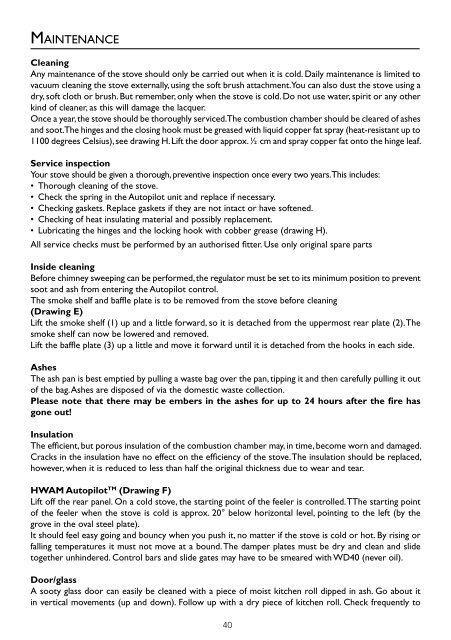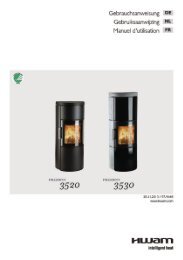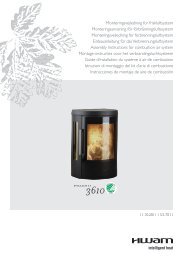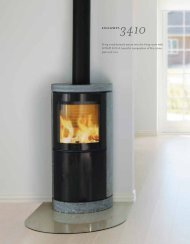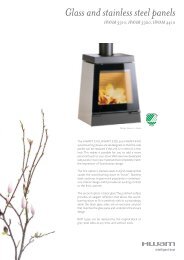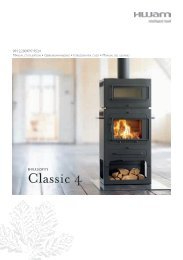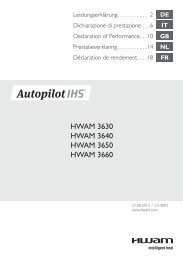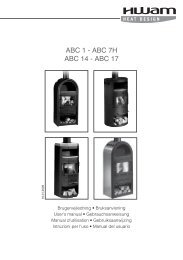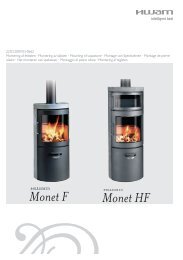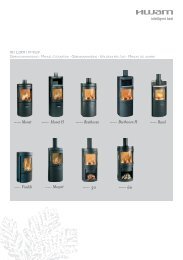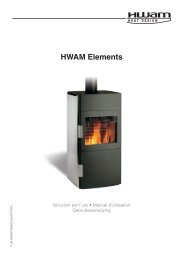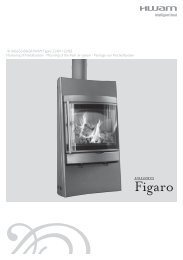prøvningsattest - Hwam
prøvningsattest - Hwam
prøvningsattest - Hwam
Create successful ePaper yourself
Turn your PDF publications into a flip-book with our unique Google optimized e-Paper software.
Maintenance<br />
Cleaning<br />
Any maintenance of the stove should only be carried out when it is cold. Daily maintenance is limited to<br />
vacuum cleaning the stove externally, using the soft brush attachment. You can also dust the stove using a<br />
dry, soft cloth or brush. But remember, only when the stove is cold. Do not use water, spirit or any other<br />
kind of cleaner, as this will damage the lacquer.<br />
Once a year, the stove should be thoroughly serviced. The combustion chamber should be cleared of ashes<br />
and soot. The hinges and the closing hook must be greased with liquid copper fat spray (heat-resistant up to<br />
1100 degrees Celsius), see drawing H. Lift the door approx. ½ cm and spray copper fat onto the hinge leaf.<br />
Service inspection<br />
Your stove should be given a thorough, preventive inspection once every two years. This includes:<br />
• Thorough cleaning of the stove.<br />
• Check the spring in the Autopilot unit and replace if necessary.<br />
• Checking gaskets. Replace gaskets if they are not intact or have softened.<br />
• Checking of heat insulating material and possibly replacement.<br />
• Lubricating the hinges and the locking hook with cobber grease (drawing H).<br />
All service checks must be performed by an authorised fitter. Use only original spare parts<br />
Inside cleaning<br />
Before chimney sweeping can be performed, the regulator must be set to its minimum position to prevent<br />
soot and ash from entering the Autopilot control.<br />
The smoke shelf and baffle plate is to be removed from the stove before cleaning<br />
(Drawing E)<br />
Lift the smoke shelf (1) up and a little forward, so it is detached from the uppermost rear plate (2). The<br />
smoke shelf can now be lowered and removed.<br />
Lift the baffle plate (3) up a little and move it forward until it is detached from the hooks in each side.<br />
Ashes<br />
The ash pan is best emptied by pulling a waste bag over the pan, tipping it and then carefully pulling it out<br />
of the bag. Ashes are disposed of via the domestic waste collection.<br />
Please note that there may be embers in the ashes for up to 24 hours after the fire has<br />
gone out!<br />
Insulation<br />
The efficient, but porous insulation of the combustion chamber may, in time, become worn and damaged.<br />
Cracks in the insulation have no effect on the efficiency of the stove. The insulation should be replaced,<br />
however, when it is reduced to less than half the original thickness due to wear and tear.<br />
HWAM Autopilot TM (Drawing F)<br />
Lift off the rear panel. On a cold stove, the starting point of the feeler is controlled. TThe starting point<br />
of the feeler when the stove is cold is approx. 20° below horizontal level, pointing to the left (by the<br />
grove in the oval steel plate).<br />
It should feel easy going and bouncy when you push it, no matter if the stove is cold or hot. By rising or<br />
falling temperatures it must not move at a bound. The damper plates must be dry and clean and slide<br />
together unhindered. Control bars and slide gates may have to be smeared with WD40 (never oil).<br />
Door/glass<br />
A sooty glass door can easily be cleaned with a piece of moist kitchen roll dipped in ash. Go about it<br />
in vertical movements (up and down). Follow up with a dry piece of kitchen roll. Check frequently to<br />
40


